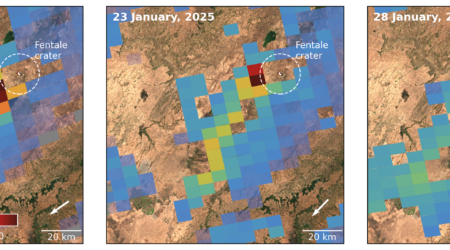Researchers call for Dutch leading role in global methane monitoring
At COP28 in Dubai, countries are looking to reach new agreements to reduce emissions. This requires the identification of emission sources. The Netherlands has extensive experience in emission monitoring from space. Researchers from SRON, KNMI, TNO and TU Delft see huge methane plumes over landfills and fossil fuel installations with their current space instrument TROPOMI. They are now jointly advocating for the Netherlands to take a leading role in identifying more of this low-hanging fruit worldwide. ‘We have all the necessary knowledge. The Netherlands has a unique opportunity to lead the world in monitoring methane, but that requires long-term commitment.’

Overview of all methane plumes measured by TROPOMI in 2021.
Human methane emissions account for a large portion – 45% – of net global warming. Unlike CO2, methane disappears from the atmosphere relatively quickly – after ten years – so less emissions quickly mean lower concentrations in the air. However, methane emissions continue to rise.
Low-hanging fruit
Because of methane’s short lifetime, tackling emissions brings quick climate benefits. What is more, some of these emissions are also highly concentrated in certain places. Huge plumes leak away from so-called super-emitters. These are often landfills, coal mines or oil and gas installations. ‘This is the low-hanging fruit in the fight against climate change,’ says Aaldert van Amerongen (SRON) of the Dutch Clear Air Consortium. ‘If we only consider the methane super-emitters we find ourselves, they already have a combined climate impact greater than the total greenhouse gas emissions of the whole of the Netherlands, including CO2. If we tackle those leaks, we can make quick climate gains with little effort. But first you have to identify them, which can be done worldwide with satellites. And this is something we are very good at in the Netherlands.’
Dutch expertise
Within the Clear Air Consortium, SRON, KNMI, TNO and TU Delft collaborate on research and technology related to emissions monitoring. Since 2017, they have discovered more and more large methane leaks with the Dutch space instrument TROPOMI. TROPOMI has daily global coverage, but relatively low resolution. That is why they are working on the TANGO satellite to measure CO2 and methane from 2027 onwards. ‘We only see the tip of the iceberg,’ says Kees Buijsrogge (TNO). ‘With better understanding of local emission sources, countries can develop more effective policies to reduce emissions. The Netherlands’ potential as a leader in this field is recognised worldwide, so we must maintain this technological leadership.’
The consortium is calling on the Dutch government to include climate research and satellite monitoring as a key mission in its long-term space agenda.
Monitoring needed
Although legislation on methane emissions is still being developed globally, several monitoring mechanisms are already being launched at COP28, by the United Nations and others. Their IMEO-MARS initiative addresses super-emitters about their leaks and makes them public after some time for repairs. ‘The UN is committed to reducing methane and CO2 emissions, but they have limited view,’ says Pepijn Veefkind (KNMI). ‘There is an urgent need for proper monitoring of greenhouse gas emissions, globally, frequently and down to the level of individual polluters. The Netherlands has the capacity to make a difference, so let us take responsibility and lead the way.’
Clear Air is a consortium of R&D organisations working on world-leading atmospheric monitoring research in support of climate action to reduce air pollution and biodiversity loss. It consists of SRON, KNMI, TNO and TU Delft.

Methane plumes from coal mines on the west coast of Australia, as seen by TROPOMI.

Duo of Satellites Detect Large Methane Emission from Ethiopian Volcano

Dutch space instrument SPEXone produces world map of aerosols

